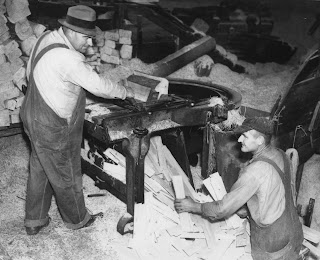(See Thursday, December 4th post for Part 1)
I got to thinking about Tom Doherty's posting about Pineys and just what makes a Piney a Piney. I'm not sure I can give you a definition, but I believe I know a Piney when I see one. In other words . . . If it walks like a duck, and quacks like a duck, then it must be a duck! Same with Pineys.
I went to my Websters Dictionary and couldn't find a definition. Finally, I Googled "Piney" and came across the following definition of Piney in Wikipedia.
Piney (Pine Barrens resident)
From Wikipedia, the free encyclopedia
Piney is a derogatory term that refers to native inhabitants of the New Jersey Pine Barrens. The Pine Barrens have sandy, acidic soil considered unsuitable for traditional farming by early settlers, who called the land "barren". The area is forested mainly with pitch pine and scrub oak. Many areas are swampy with cedar forests that grow along brownish-red, fresh water called "cedar water". The red color is actually created by the high level of iron-ore in the soil.
Living conditions in the "Barrens" were considered inhospitable, and those that lived there were considered to be the dregs of society, fugitives, poachers, moon-shiners, runaway slaves or deserting soldiers. Often poor, Pineys were forced to make a living in any way possible. They collected and sold sphagnum moss or pine cones, hunted, fished, and lived off of the land. Some of the pineys included notorious bandits known as the Pine Robbers.
Pineys were further demonized after two eugenics studies in the early 20th century, which depicted them as congenital idiots and criminals, most notably the research performed on "The Kallikak Family" by Henry H. Goddard. Pineys often fostered stories of how terrible the Pine Barrens are or how violent they were in order to discourage outsiders and law enforcement from entering the Barrens. The Jersey Devil stories often had this effect.
Today, pineys tend to wear the label as a badge of honor, much like the term "redneck" has become in the Appalachian Mountains and the Southern United States.

Piney Bumper Sticker
Well, after reading that definition, I'm still not sure I could tell you what a Piney is. I do tend to think of certain occupations when I think of Pineys. In other words a Piney is someone who lives off of the land, off of his Pine Barrens surroundings. They are his universe and shape what he does and who he is.
Rev. Henry Charlton Beck who wrote "Jersey Genesis" and other books on the Pinelands, talked with and wrote about many Pineys in his travels throughout the Pinelands in the 1930s and 1940s. When reading Beck I often stop and say, "Now, there is a Piney!". In other words, he walks like a duck!
Most people don't realize that Beck began his writings on the Jersey Pine Barrens, it's people and it's towns, as a reporter with the Newark Star Ledger. The material in most of his books came from these newspaper articles. An important addition to Beck's newspaper articles and books were the great photos which were taken by William Augustine who traveled throughout the Pinelands with Beck, taking photos as Beck talked with the locals. Augustine is an unsung hero when it comes to the history of the Pine Barrens. His great photo collection is now housed in the Rutgers University Library in New Brunswick. I was able to go there some years ago with my lap top computer and scanner and scan many of Augustine's photos from our area. These photos are, perhaps, the best definition of what a Piney is. Well, they do say that a picture is worth a thousand words!
Following are a few of William Augustine's photos from the Rutgers University collection. You can look at them and know that you are looking at a Piney. Notice that each of the photos shows some form of Pine Barrens related work. Who said that Pineys are lazy and don't work? They were proud, hard working, independent people! We could use more of them today. - Pete S.
Sammy Ford at his moss press.
Joe Ware (l), my friend Howard Ware's father, and Ed Weber (r) sawing shingles at Joe's saw mill.
George Crummel building a charcoal mound.
Click on the following to read a Batsto Gazette article on George Crummel . . .
Selling pine cones along the road.
Charlie Weber, Sr., Elaine Weber Mathis' grandfather, cut salt hay in the meadows along the Pinelands rivers.
Lance Cobb repairing his fyke nets.
Jack Updike carving a decoy.








No comments:
Post a Comment